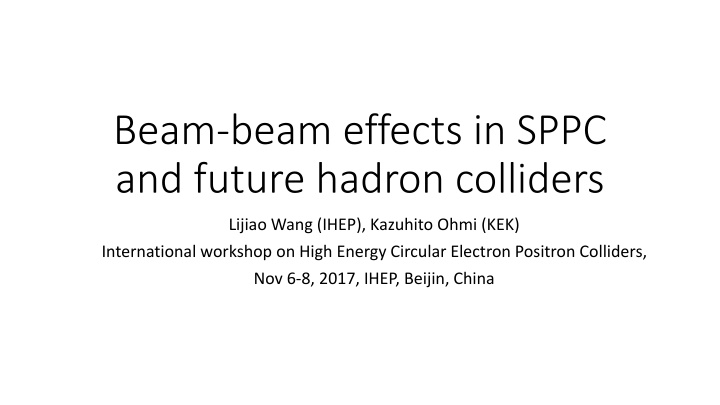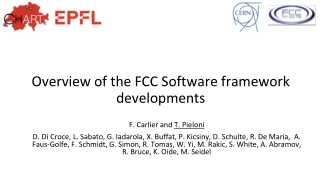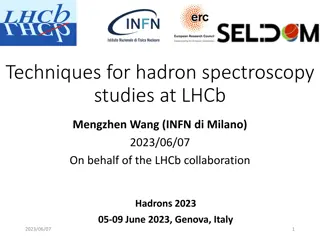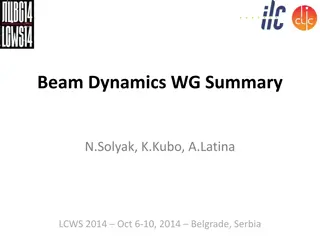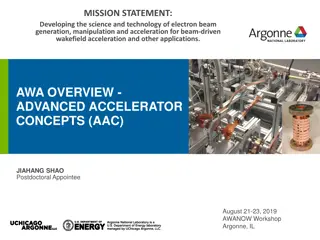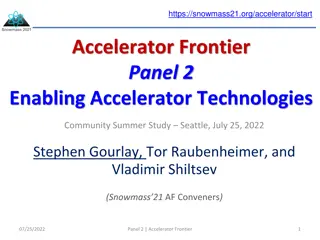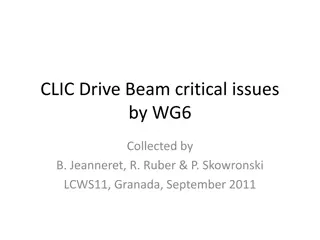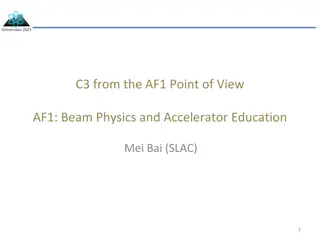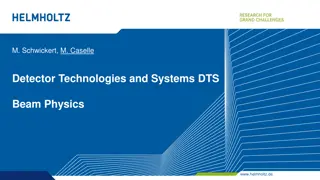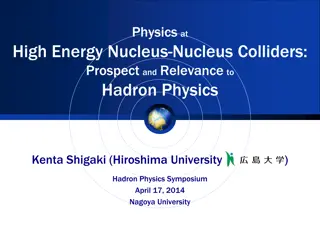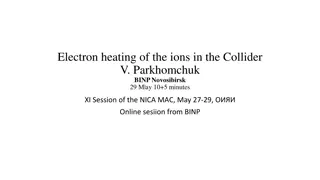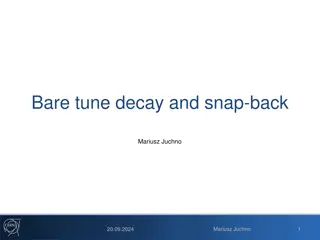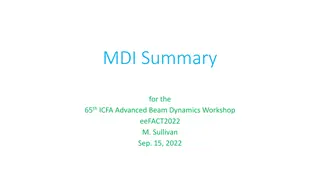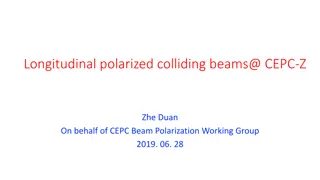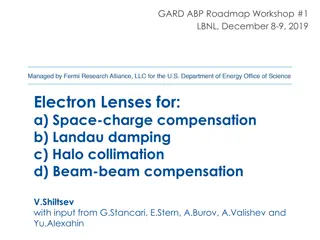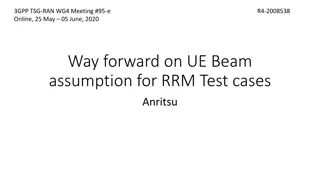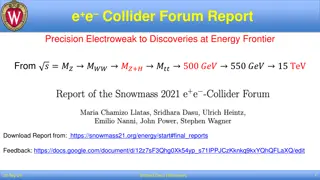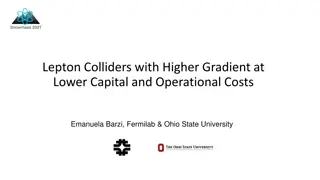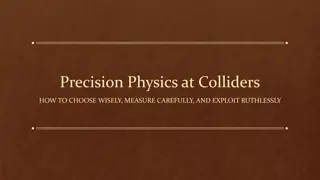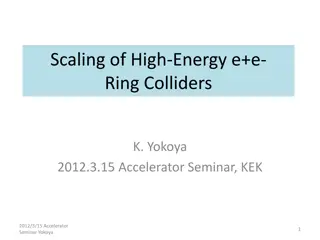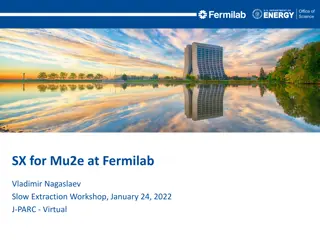Beam-beam Effects in Future Hadron Colliders Workshop
Explore the beam-beam effects in the SPPC and future hadron colliders, presented at the International Workshop on High Energy Circular Electron-Positron Colliders. The workshop covers weak-strong beam-beam simulations, collision models, and parameter values for the SPPC. Detailed discussions on the impact of beam-beam resonances, luminosity decay rates, and particle tracking simulations for 2-IP configurations are provided.
Download Presentation

Please find below an Image/Link to download the presentation.
The content on the website is provided AS IS for your information and personal use only. It may not be sold, licensed, or shared on other websites without obtaining consent from the author.If you encounter any issues during the download, it is possible that the publisher has removed the file from their server.
You are allowed to download the files provided on this website for personal or commercial use, subject to the condition that they are used lawfully. All files are the property of their respective owners.
The content on the website is provided AS IS for your information and personal use only. It may not be sold, licensed, or shared on other websites without obtaining consent from the author.
E N D
Presentation Transcript
Beam-beam effects in SPPC and future hadron colliders Lijiao Wang (IHEP), Kazuhito Ohmi (KEK) International workshop on High Energy Circular Electron Positron Colliders, Nov 6-8, 2017, IHEP, Beijin, China
Introduction Weak-strong Beam-beam simulation for SPPC. 1. HH/HV crossing and without crossing. No long range 2. 2-IP HH crossing with long range (82 locations) 3. 2-IP HV crossing with long range (82 locations) Tune shift and beam-beam resonances
Institute of High Energy Physics SPPC relative parameter Value Unit CDR 100 37.5 2 3 Ultimate 100 62.5-75 2 3 Circumference Beam energy Number of IPs Revolution frequency Physics performance and beam parameters Peak luminosity per IP Beta function at collision Circulating beam current Nominal beam-beam tune shift limit per IP Bunch separation Number of bunches Bunch population Normalized rms transverse emittance Turnaround time inelastic cross section total cross section Full crossing angle km TeV kHz 1.01 1035 0.75 0.7 0.0075 25 10080 1.5 1011 2.4 3 105 148 110 - - - - - - - - - - - - cm-2s-1 m A ns m hours mb mb urad
Main collision (weak-strong model) bunch slice, zi,i=1,nsl=10. Collision point between particle (z) and slice(zi), . Transfer to collision point sifrom s*, and slice center in x,y 2+ ?? 2)/4 ??2(??) = (??+?? ? = ? + ???? ? = ? + ???? ??= ?? (?? 2 ??)?? ? = ? ??(??) ? = ? ??(??) Collision (round beam) repeat nsltimes ? = ? + ??(??) ? = ? + ??(??) ? = ? ???? ? = ? ???? 2+ ?? 2)/4 ??= ??+ (?? Inverse transformation to s=s*.
Transf. for Crossing angle, c: half crossing angle Central position of slices, Before collision ? = ? + ??? ???? = ???? ??= ?? ???? Main collision (last page) After collision ? = ? ??? ??= ??+ ???? ??? ??2 ??? ??? |?? ??|2 1 Luminosity ? = 2???2 2??2 ?=1
Simulation for 2-IP with HH,HV crossing and without crossing. No long range. Initialize 131072 particle with random number generator, and track particles in 106revolutions. Parallel computation using OMP. Luminosity and beam size are averaged every 100 turns. Luminosity plot over every 100 turns and fit using f(x)=a+b*x Luminosity decay rate/day is estimated. f0=3kHz=2.6x108/day
1-IP H with crossing. No long range (tunex=0.655,tuney=0.16)=2IP HH crossing Design parameter: Np=1.5e11 a= 1.00958e+31 (0.000467%) b= 3.29834e+20(2476%) Np=2*1.5e11 a= 4.0171e+31 (0.0004706%) b= 5.7786e+22(56.66%) Np=5*1.5e11 a=2.45031e+32 (0.0005675%) b= -5.17266e+21(0.5344%) a= 9.10413e+32 (0.001894%) b= -1.17056e+27(0.2551%) Np=10*1.5e11
Beam size averaged over every 100 turns in 106revolutions. X direction(bsize )
1. 2-IP HH, HV crossing and without crossing. No long range = = rad = = rad = = rad rad rad rad 0.655,0.16 /IP 0.007633 Tune/IP HH HV L/L0(per day) 0 L/L0(per day) L/L0(per day) Np 1.5e11 0 0 2*1.5e11 0.015266 0 0 0 5*1.5e11 0.038165 0 0 -14.5 10*1.5e11 0.076330 -0.26 -6.66 -203 20*1.5e11 50*1.5e11 0.152659 0.381649 -2.36 -380 -210 -494 -309 -231 100*1.5e11 0.763297 -552 -436 -215 Tune (LHC) 0.31,1.32->0.155,0.66/IP
Long range interaction y Tune spread x
Twiss parameters in IR Institute of High Energy Physics IP SPPC twiss parameters in IR LHC twiss parameters in IR Long range interaction: every 3.75m.
X-separation Institute of High Energy Physics Horizontal separation(sigma)
Long range interaction repeat nu=42 times Transfer IP to upstream LR location(su), using ??0. LR interaction with offset xu, yu. Transfer upstream LR location(su), to IP using ??0 1. Main collision with crossing angle (last two pages) repeat nd=42 times Transfer IP to downstream LR location(su), using ??0. LR interaction with offset xd, yd. Transfer downstream LR location(sd), to IP using ??0 1.
Closed orbit distortion due to long range interaction Beam deflection due to long range interaction, upstream ??<0. ??,?= 2???? ? ?? 1 Effective momentum, position kick at IP ?? ?? ??,? ?? ??,?sin(?? ??) ??,? ????= ?? ??) ??,? ??,???= cos(?? ?=1 ?=1 Downstream, ??>0. The same formula, u->d. ????= 3.66 ?m ????= 4.08 ?m ??,???= 0.100?rad ??,???= 0.125?rad
HH crossing with long range bb force long range (82 locations)/IP Tune/IP=0.655,0.16 or 0.155,0.66 Initialize 131072 particle with random number generator at a closed orbit with take into account of diffraction due to long range beam-beam. (Initialized at before upstream long range bb. The closed orbit depends on beam intensity and Pacman.) ?0 ?0 ?0 ?? ?0 ?? ?? ?? = ????/2 + + The particles are tracked in 106revolutions. Parallel computation using OMP. We consider long-range interactions using round beam instead of flat beam. Results did not change in several cases. Beam life time is evaluated for the aperture 5 or 7 .
Closed orbit at IP on Main collision Determine closed orbit using the periodic condition in the half ring. ?0 ?0 ?0 ?0 ?? ?? ?? ?? = + ????/2 + ? cot?? 1 1=1 ?0 ?0 ?? ?? ?? ?? 1 1 ? ???? = ? ????/2 + ????/2 ? cot?? 1 2 MDRU Tunex=0.655 Tuney=0.16 MDRU Tunex=0.155 Tuney=0.66 X distortion Px distortion X distortion Px distortion Design 2.03053e-07 -2.844e-06 Design 2.25166e-07 9.63179e-06 2 times 4.06106e-07 -5.688e-6 2 times 4.50332e-07 1.92636e-05 3 times 6.09159e-07 -1.7064e-5 3 times 6.75498e-07 2.88954e-05 4 times 8.12212e-07 -1.1376e-5 4 times 9.00664e-07 3.85272e-05
H/H crossing with long range (82 locations) tune/IP=0.655,0.16 R R= = R R= = = = rad rad /IP Np Beam lifetime Beam lifetime Luminosity decay(one day) 0.00763 275.82h(44 particles lost) 27.21h(223 particles lost) 0 1.5e11 0.01526 0.08h(76643 particles lost) 0.08h(77121 particles lost) -12.04 2*1.5e11 0.02289 23.61h(257 particles lost) 0.08h(82212 particles lost) -5.1 3*1.5e11 0.03052 1.48h(4107 particles lost) 0.13h(53391 particles lost) -7.16 4*1.5e11 H/H crossing with long range (82 locations)/IP tune/IP=0.155,0.66 R R= = R R= = = = rad rad /IP Np Beam lifetime Beam lifetime Luminosity decay(one day) 0.00763 (no particles lost) 148h (41 particles lost) 0 1.5e11 0.01526 (no particles lost) 21.52h(282 particles lost) -0.114 2*1.5e11 0.02289 2.14h(2839 particles lost) 1.35h(4507 particles lost) -2.26 3*1.5e11
Initialize 30 particles with x=0,0.1,0.2.2.9, px=y=py=z=pz=0, and plot x-px in 1000 revolutions. px x Np=2*1.5e11 Np=1.5e11 Tune/IP=0.655,0.16 Horizontal tune shift is positive for the long range beam-beam force. At 2 times intensity of the design, 3rdorder resonance appears and luminosity degradation becomes serious. Np=3*1.5e11
Initialize 30 particles with x=0,0.1,0.2.2.9, px=y=py=z=pz=0, and plot x-px in 1000 revolutions. px x Np=1.5e11 Np=2*1.5e11 Tune/IP=0.155,0.66 No 3rdorder resonance. Tune/IP=0.155,0.66 is better than 0.655,0.16 Np=3*1.5e11
Horizontal Vertical crossing Horizontal orbit at IP-H and vertical orbit at IP-V are obtained each using previous method. Vertical orbit at IP-H and horizontal orbit at IP-V The closed orbit depends on the bunch population and on position in the bunch train. Initialize 131072 particle with random number generator at the closed orbit and tracked in 106revolutions.
Horizontal Closed orbit at the vertical collision point ?0 ?0 ?0 ?0 ?? ?? ?? ?? = ???? + ????/2 + ?0 ?0 ?? ?? ?? ?? RxUxMxDx RyUyMyDy Tunex=0.31 Tuney=1.32 RxUxMxDx RyUyMyDy Tunex=1.31 Tuney=0.32 1????/2 = ? ???? + ? X distortion Px distortion X distortion Px distortion 0 ? cot?? ? sin?? 1 cos?? 1 ? sin?? 3 times =1 1.10561e-08 2.21122e-08 sin?? 6.23789e-06 Design Design -1.10561e-8 -6.23789e-6 1????/2=1 -2.21122e-8 1 1 ? ???? 2 ? cot?? -1.87137e-5 1 cos?? 2 times 1.24758e-05 2 0 2 times -1.24758e-5 ? sin?? 3.31683e-08 1.87137e-05 3 times -3.31683e-8 4 times 4.42244e-08 2.49516e-05 4 times -4.42244e-8 -2.49516e-5 The orbit distortion should be corrected.
Vertical Closed orbit at the Horizontal collision point ?0 ??0 ??0 ?0 ?? ??? ?? ??? = ???? + ????/2 + ?0 ?0 Y distortion ?? ?? RyUyMyDy ?? ?? RxUxMxDx RyUyMyDy Tunex=1.31 Tuney=0.32 RxUxMxDx Tunex=0.31 Tuney=1.32 1????/2 = ? ???? + ? Py distortion Y distortion Py distortion 0 ? cot?? ? sin?? 1 cos?? 1 ? sin?? 2 times 3 times =1 1.08308e-08 sin?? -6.11047e-06 1????/2=1 -2.16616e-8 Design -1.08308e-8 6.11047e-6 Design 1 1 ? ???? 2 times 2 ? cot?? 1 cos?? 2 0 1.22209e-5 2.16616e-08 -1.22209e-05 ? sin?? 3 times -3.24924e-8 1.83314e-5 3.24924e-08 -1.83314e-05 4 times -4.33232e-8 2.4419e-5 4 times 4.33232e-08 -2.44419e-05 The orbit distortion should be corrected.
Initialize 10 particles with x=0,0.1,0.2.0.9, px=y=py=z=pz=0, and plot x-px in 1000 revolutions. px x Np=1.5e11 Np=2*1.5e11 Tune/IP=0.155,0.66 Vertical/horizontal closed orbits at IP-H/V are not corrected. Complex chaotic behavior is seen. px Np=3*1.5e11
Initialize 10 particles with x=0,0.1,0.2.0.9, px=y=py=z=pz=0, and plot x-px in 1000 revolutions. px x Np=1.5e11 Np=2*1.5e11 Tune/IP=0.155,0.66 Vertical/horizontal closed orbits at IP-H/V are corrected. Regular phase space structure is seen. Np=3*1.5e11
4. 2-IP HV crossing with long range (164 locations) R R= = R R= = = = rad rad Tune/IP 0.655,0.16 0.655,0.16 0.655,0.16 /IP Np Beam lifetime Beam lifetime Luminosity decay(one day) 0.00763 (no particles lost) 216.72h (56 particles lost) 0 1.5e11 0.01526 58.35h(208 particles lost) 16.20h(749 particles lost) -0.13 2*1.5e11 0.02289 1.03h(11812 particles lost) 0.92h(13146 particles lost) -11.56 3*1.5e11 R R= = R R= = = = rad rad Tune/IP 0.155,0.66 0.155,0.66 0.155,0.66 /IP Np Beam lifetime Beam lifetime Luminosity decay(one day) 0.00763 (no particles lost) 216.72h (56 particles lost) 0 1.5e11 0.01526 58.91h (206 particles lost) 13.95h (772 particles lost) -0.14 2*1.5e11 0.02289 1.03h (11744 particles lost) 0.93h (13054 particles lost) -11.52 3*1.5e11
4. 2-IP HV crossing with long range (164 locations) with correcting orbit R R= = R R= = = = rad rad Tune/IP 0.155,0.66 0.155,0.66 0.155,0.66 /IP Np Beam lifetime Beam lifetime Luminosity decay(one day) 0.00763 (no particles lost) 220.66h (55 particles lost) 0 1.5e11 0.01526 263.8(46 particles lost) 17.46(695 particles lost) -0.085 2*1.5e11 0.02289 8.76h (1385 particles lost) 3.15h (3418 particles lost) -2.22 3*1.5e11 Tune/IP=0.155,0.66 The orbit correction of Horizontal/vertical closed orbits at IP-V/H works well. The correction is dependent of beam intensity and PACMAN. The performance of HV with the orbit correction is similar as HH.
Summary Weak-strong Beam-beam simulations are performed for SPPC. 1. HH/HV crossing and without crossing. No long range 2. HH/HV crossing with long range (82 locations) Beam-beam limit for collision without crossing /IP=0.15 for luminosity lifetime shorter than 1 day . /IP=0.076 for HH crossing and 0.038 for HV crossing. Considering Long range interaction lim/IP=0.015-0.023 for both of HH and HV crossing. The design of SPPC, /IP=0.0075, is reasonable.
Packman bunch For example, first bunch of a train experiences long range interactions only downstream of IP. Regular bunches MDRU Tunex=0.155 Tuney=0.66 Tunex=0.155 Tuney=0.66 HH X distortion Px distortion X distortion Px distortion Design 2.1268e-06 5.0716e-06 2.25166e-07 9.63179e-06 2 times 4.2537e-06 1.0143e-05 4.50332e-07 1.92636e-05 3 times 6.3804e-06 1.5215e-05 6.75498e-07 2.88954e-05 MDRU Tunex=0.155 Tuney=0.66 X distortion at IP-H Px distortion Y distortion Py distortion HV Design 2.0704e-06 1.7850e-06 4.447e-08 2.891e-06 2 times 3 times Different orbit from that of the regular bunches.
Tuneshift footprint(long-range ) X-separation Y-separation nuy nuy nux 0.002 0.004 0.006 0.008 0.008 0.002 0.006 0.004 0.006 0.004 0.008 0.002 0.010 nux 0.010 0.008 0.006 0.004 0.002
Tuneshift footprint Head-on and long-range Combined head-on and long-range nuy nuy 0.010 nux 0.015 0.010 0.005 0.005 SPPC nux 0.015 0.010 0.005 0.005 0.005 0.005 0.010 0.010 0.015 0.015 LHC
Closed orbit at IP on Main collision Determine closed orbit using the periodic condition. ?0 ?0 ?0 ?0 ?? ?? ?? ?? = + ????/2 + ? cot?? 1 1=1 ?0 ?0 ?? ?? ?? ?? 1 1 ? ???? = ? ????/2 + ???? ? cot?? 1 2 ????= 3.66 ?m ????= 4.08 ?m ??,???= 0.100?rad ??,???= 0.125?rad ?0 ?0 0.214 ?m 3.39 ?rad =
